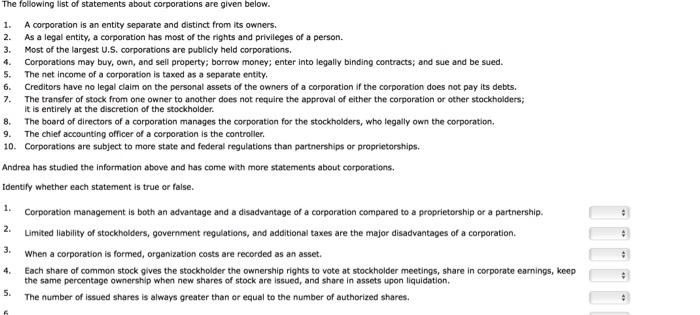Answered step by step
Verified Expert Solution
Question
1 Approved Answer
The following list of statements about corporations are given below. 1. A corporation is an entity separate and distinct from its owners. 2. As


The following list of statements about corporations are given below. 1. A corporation is an entity separate and distinct from its owners. 2. As a legal entity, a corporation has most of the rights and privileges of a person. 3. Most of the largest U.S. corporations are publicly held corporations. Corporations may buy, own, and sell property; borrow money; enter into legally binding contracts; and sue and be sued. The net income of a corporation is taxed as a separate entity. Creditors have no legal claim on the personal assets of the owners of a corporation if the corporation does not pay its debts. 7. The transfer of stock from one owner to another does not require the approval of either the corporation or other stockholders; it is entirely at the discretion of the stockholder. 8. The board of directors of a corporation manages the corporation for the stockholders, who legally own the corporation. The chief accounting officer of a corporation is the controller. 4. 5. 6. 9. 10. Corporations are subject to more state and federal regulations than partnerships or proprietorships. Andrea has studied the information above and has come with more statements about corporations. Identify whether each statement is true or false. 1. Corporation management is both an advantage and a disadvantage of a corporation compared to a proprietorship or a partnership. 2. Limited liability of stockholders, government regulations, and additional taxes are the major disadvantages of a corporation. 3. When a corporation is formed, organization costs are recorded as an asset. 4. Each share of common stock gives the stockholder the ownership rights to vote at stockholder meetings, share in corporate earnings, keep the same percentage ownership when new shares of stock are issued, and share in assets upon liquidation. 5. The number of issued shares is always greater than or equal to the number of authorized shares. 4. Each share of common stock gives the stockholder the ownership rights to vote at stockholder meetings, share in corporate earnings, keep the same percentage ownership when new shares of stock are issued, and share in assets upon liquidation. 5. The number of issued shares is always greater than or equal to the number of authorized shares. 6. A journal entry is required for the authorization of capital stock. 7. Publicly heid corporations usually issue stock directly to investors. The trading of capital stock on a securities exchange involves the transfer of already issued shares from an existing stockholder to another investor. 8. 9. The market price of common stock is usually the same as its par value. 10. Retained earnings is the total amount of cash and other assets paid in to the corporation by stockholders in exchange for capital stock.
Step by Step Solution
★★★★★
3.41 Rating (148 Votes )
There are 3 Steps involved in it
Step: 1
Answer1 True Corporation management is both an advantage and a disadvantage Corporation management ...
Get Instant Access to Expert-Tailored Solutions
See step-by-step solutions with expert insights and AI powered tools for academic success
Step: 2

Step: 3

Document Format ( 2 attachments)
636289883312b_234555.pdf
180 KBs PDF File
636289883312b_234555.docx
120 KBs Word File
Ace Your Homework with AI
Get the answers you need in no time with our AI-driven, step-by-step assistance
Get Started


